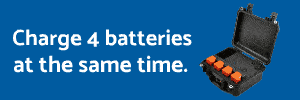Post below is from Ken Booth on the Autel Facebook Page, September 27 2021, it is a good read.
Excellent Read.. If you ever want to know more about Li-ion or Li-Po battery protection circuits and state of charge determination algorithms, most of the common IC's used for this have detailed datasheets.
Summary of Ken's post;
- Preheat packs if working in cold conditions, cold packs will cause operational instability in the battery protection systems.
- self-discharge safety systems are overly cautions to prevent incident and can interfere with the state-of-charge (SOC) algorithms
- Never fly on a partially charged pack unless it was cycled the same day.
- Never fly on a pack that has undergone self discharge unless it was cycled the same day.
- Never keep a pack fully charged for more than 1 or 2 days max to optimize battery lifespan (this is like storing rubber bands in your desk stretched out)
- Do not routinely discharge a pack below 20% to optimize battery lifespan
-----------------------------------
It’s that time of year again!!
Posted Earlier but good information for new users or even seasoned users that don’t fully understand these type of packs. I was requested to provide a little more information how cold and or heat can affect li-po batteries. First please look at the attached image, this should really explain all you need to know on how cold effects capacity. Once you understand this, most of the other pieces come together.
Now that we understand what cold does to capacity let us talk about overall discharge. Most of us know that C is based on overall capacity, so if your capacity goes down, so will your C rating. Unfortunately, Autel, DJI and others does not use batteries that have much overhead, this is mostly due to keep the weight down at a certain price point. So, when we start to pull from this cold battery a few things can happen. If the pack has not been preheated, it will start to preheat itself. You are probably asking; well if that’s the case, why do I have to worry about preheating? Well, if the battery is too cold and C rating has been affected, it will not be able to supply enough output (required C), going over its current C rating due to loss of capacity. This starts heating the pack up rapidly. Which in turn makes the pack quickly go past normal operating temperatures, which will also decrease output. This will cause immediate damage and more than likely a cell failure under extreme conditions. This is called thermal runaway.
The next thing that can happen is part of the smart logic and safety features of these packs. Since the cold does affect overall capacity, this could kick the overcharge protection in and start a self-discharge of the pack(s). In theory this is good and prevents possible damage or even a fire but can also play with the SOC (state of charge) that calculates the current charge state. While the logic is pretty darn good its not perfect. The percentage could be off as much as 20-30%. The same goes for an automatic timed self-discharge, you NEVER want to fly a pack that has been allowed to self-discharge. I would also highly advise to never fly ANY partially discharged pack unless that pack has been used that same day.
So, what can we do to help or minimize these issues?
Preheat packs in cooler weather. I would say anything below 55F you should start paying attention. One easy way to keep packs nice and warm in colder weather is dry rice and an ice chest / bag. Take a few pounds of dry rice (this depends on how big of a cooler you have) and place the rice in a large zip-lock bag(s). Microwave the rice for about 5-10mins or until very hot. Place the rice in the cooler. This should keep packs warm for most of the day. I prefer this method since the rice is reusable and does help with small amounts of moisture as well.
DO NOT Keep full pack charged for more than 24, 48 hours MAX! Any type of lipo does not like to be kept fully charge for a long period. This is not just for smart packs, any lipo will degrade over time if kept in a full charge state. Signs of this can be shorter flight times and possibly puffing (gassing) in extreme cases.
DO NOT over discharge your packs. Anything past 20%, consider it a reserve. If you commonly go past this 20% mark you will shorten you packs life. This is extremely important during extreme temps, both hot and cold weather.
DO NOT expect the same performance. In cold weather, even after preheating. Some craft keep packs warmer than others. Be easy on the packs, especially at the start of the flight, even after preheating.
Stop and hover. This is important for ANY time of year and should be included in you SOP. When you first take off, stop and hover for at least a minute. Even prior to a mapping run, take off and hover for a minute before the start of a mission. It is worth that 1 or 2mins less of mission time. Check all controls and watch the behavior of the craft. If you start to see drifting or any odd behavior, that is your clue to land and diagnose the issues. You would be surprised at how many logs of failures I have seen and the first thing the operator does is a punch out. This is probably the worst thing you can do with these types of craft. When these craft are not well, they usually show signs at the begging of flight. I simple hover with some minor control inputs can do wonders at showing a healthy or sick craft. This also allows the internals of the craft and packs to start warming up properly.
Check voltages and balances in the app and not percentages. Always have voltage options turned on. This is something to check when you are doing the hover and control test at the start of flight. Open the battery menu and check each cell, make sure everything looks good. Make sure you do not see any cells dropping rapidly and or voltage issues.
Voltages. A freshly charged pack should be around 4.2-4.3v per cell. A clue to a bad SOC is a percentage showing 99-100% but a much lower voltage. Once again, during that initial hover period check the cell voltages or overall voltage. If you see something like 3.9v at 99-100% charge, that pack either has a SOC issue or the pack is not healthy. If you do see any anomalies, do not risk it! Land and swap the packs.
Maintenance. With smart packs there’s only a few basic maintenance items you must be aware of. For older packs such as the p4 pack I would still recommend bringing these packs down below 10% every 20-30 flight or after long periods of storage. When you go past 20% make sure you are not flying hard and only hovering at a low altitude. The key here is to drain the pack as slow and gently as possible. What this does is perform something like a soft reset (calibration) on the SOC counter. Now if you are constantly using packs and not abusing them, you more than likely do not have to worry about a calibration. But remember long period of storage might require this to get the battery back to calculating accurately. After long storage periods its always best practice to monitor the pack during the initial flight. I know I am anal but if a pack has sat more than 3 months, I fully charge and then hover for the entire flight down to 20%. During this flight I am constantly monitoring the packs performance via the battery window. If the pack is not well this will usually show signs, especially voltages and balance issues.
Newer packs such as the m2 and enterprise models should not require this and most issues we see are due to storage charge and temperatures. With that being said, there are times a good battery calibration can bring back unhealthy packs in these new generation smart batteries.
I know I have probably missed some stuff, but it is simple. Keep packs above 60F in cold weather, not push them hard, do not keep batteries fully charged for long periods of time and do not store while fully charged in cold conditions.
I understand for first responders, a lot of this is hard to do but you must develop a battery maintenance schedule. Batteries still need to be cycled. I would suggest at least twice a week down to 50% if kept at full levels.
One more thing, please know that warm weather works in a very similar way. You do not want packs starting off too warm. Try to keep packs below 90F prior to flight. Also, the same with storage, never store fully charged packs in extreme temperatures.
I have tried my best to not get too technical and put it laymen terms as best as I could. If you have further questions, please let me know!









